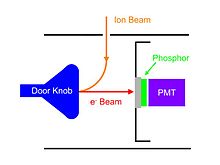- Daly detector
-
Daly detector 
Schematic of a Daly detectorInventor Norman Richard Daly Related items Microchannel plate detector
Electron multiplierA Daly detector is a gas phase ion detector that consists of a metal "doorknob", a scintillator (phosphor screen) and a photomultiplier.[1] It was named after its inventor Norman Richard Daly. Daly detectors are typically used in mass spectrometers.
How it works
Ions that hit the doorknob release secondary electrons. A high voltage (ca. -20,000 V) between the doorknob and the scintillator accelerates the electrons onto the phosphor screen where they are converted to photons. These photons are detected by the photomultiplier.
The advantage of the Daly detector is that the photomultiplier can be separated by a window, which lets the photons through from the high vacuum of the mass spectrometer, which an otherwise possible contamination prevented and which extends detector life span. The Daly detector also allows for a higher acceleration after the field free region of a time-of-flight mass spectrometer flight tube, which can improve the sensitivity for high mass ions.
References
- ^ N. R. Daly, Scintillation Type Mass Spectrometer ion Detector. Rev. Sci. Instr. 3, 31, 264-267 (1960).
Mass spectrometry Mass • m/z • Mass spectrum • MS software • Acronyms Ion source Mass analyzer Detector MS combination Fragmentation Categories:- Mass spectrometry
- Measuring instruments
- Photochemistry
- Particle detectors
- Phosphors and scintillators
Wikimedia Foundation. 2010.
